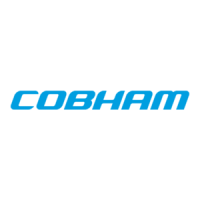2201R Mobile Tester SCPI Reference Guide
Chapter 2 Remote control of the 2201R Mobile Tester
47090/323
Copyright © 2016 Aeroflex Limited. All rights reserved.
33
How to convert a result string back into numeric variables
The example program below illustrates how the returned string can be converted back into numeric variables in a
program on an external PC controlling the instrument.
PRINT #scpi, “:MEAS:GSM:RFTX:ALL?”
INPUT #scpi, result$
index = 0
result$ = result$ + “,”
DO
‘ Find the position within result$, where the first comma appears
P = INSTR(result$, “,”)
’ Read out the part of result$ in front of the first comma and convert it into
a numeric value
result(index) = VAL(LEFT$(result$, P – 1))
’ Cut off the value just read from result$
result$ = MID$(result$, P +1))
index = index + 1
Query
The query form of any MEASure command starts the (continuous) measurement of
the specified measurable property.
The CONTinuous command element is optional.
After the first measurement has been completed, the measurement result value(s)
are delivered back in a string as outlined above.
Should the query fail to obtain a measurement result value, a timeout occurs and an
error message is added to the 2201’s internal error queue as explained above.
The main application of the query form of a MEAS command is speed. When com-
bined with ‘fast’ measurements (like e.g. the fast power level measurement), the
query form of a MEAS command delivers measurement results as fast as possible.
Note: The measurement started with the query form of the MEAS command contin-
ues in the background. Any further measurement result values may be read out, using
the appropriate FETCh command.
Examples
:MEASure:GSM:CONTinuous:RFTX:PPEAk and
:MEASure:GSM:RFTX:PPEAk
are identical. Either command starts the measurement of the peak phase error. The
latest result of this measurement (like “5.84”) is stored internally. It is overwritten
as soon as a new measurement result has been achieved.
To read out the current measurement result, use the FETCh subsystem:
:FETCh:GSM:RFTX:PPEAk?
:MEASure:RFTX:ALL
This command starts the continuous measurement of all relevant RFTX parameters.
After this command has been issued, you may continue with e.g. an RF RX MEASure
command.
All 19 single measurement results are stored internally. As soon as a new measure-
ment result has been achieved, the previous value is overwritten.
To read out the measurement results achieved by the :MEAS:RFTX:ALL com-
mand, use the :FETCh:GSM:RFTX:ALL? command.
:MEASure:GSM:RFTX:ALL?
As in the example above, the continuous measurement of all relevant RFTX parame-
ters is started. Unlike the example above, this command waits until all
19 measurement results have been achieved and returns all of them in a string, sepa-
rated by commas. The measurements continue and later results may be read out,
using the FETCh:GSM:RFTX:ALL? command.

